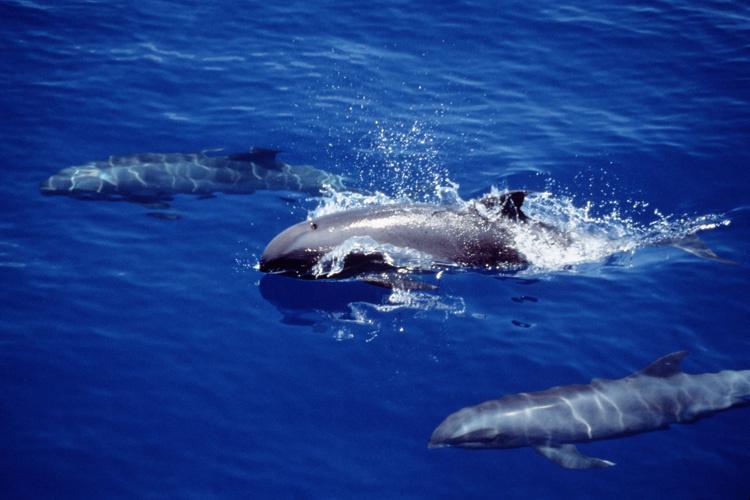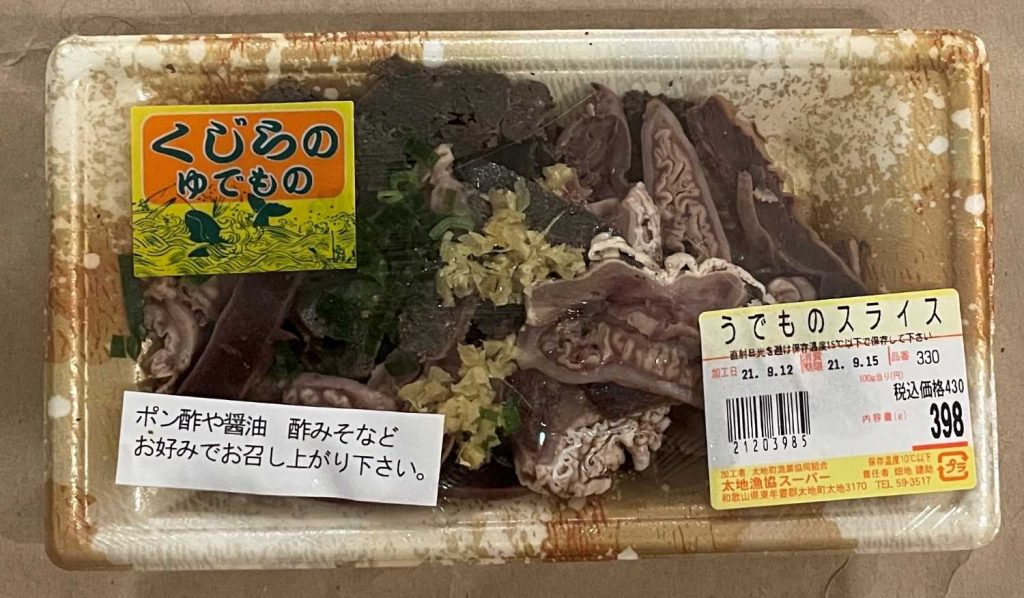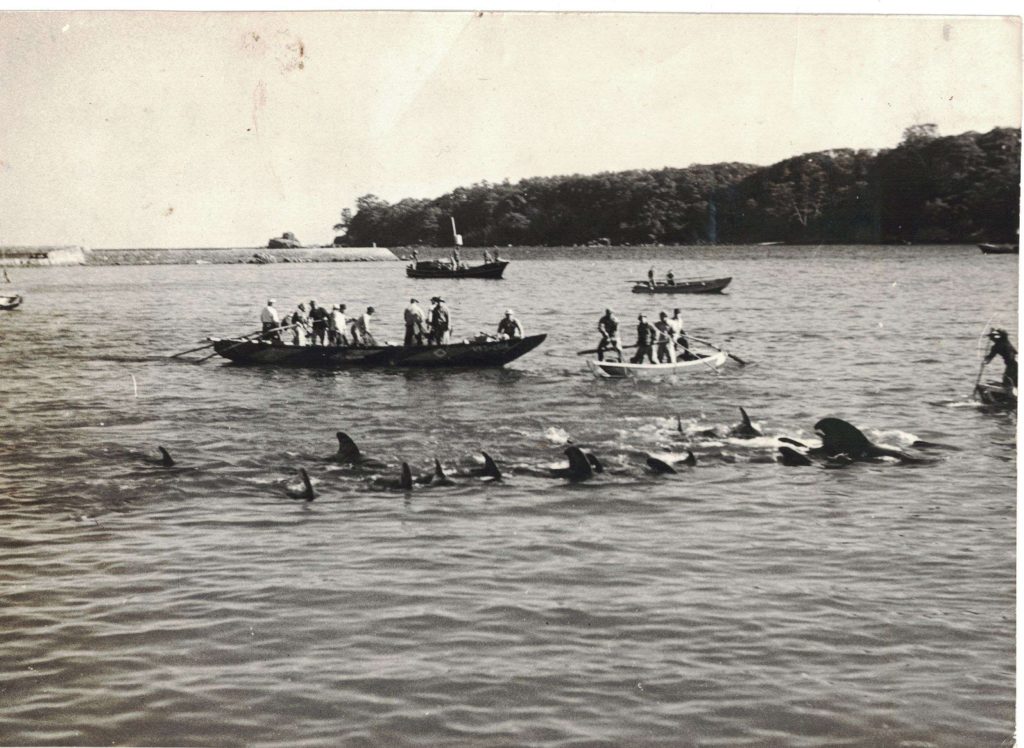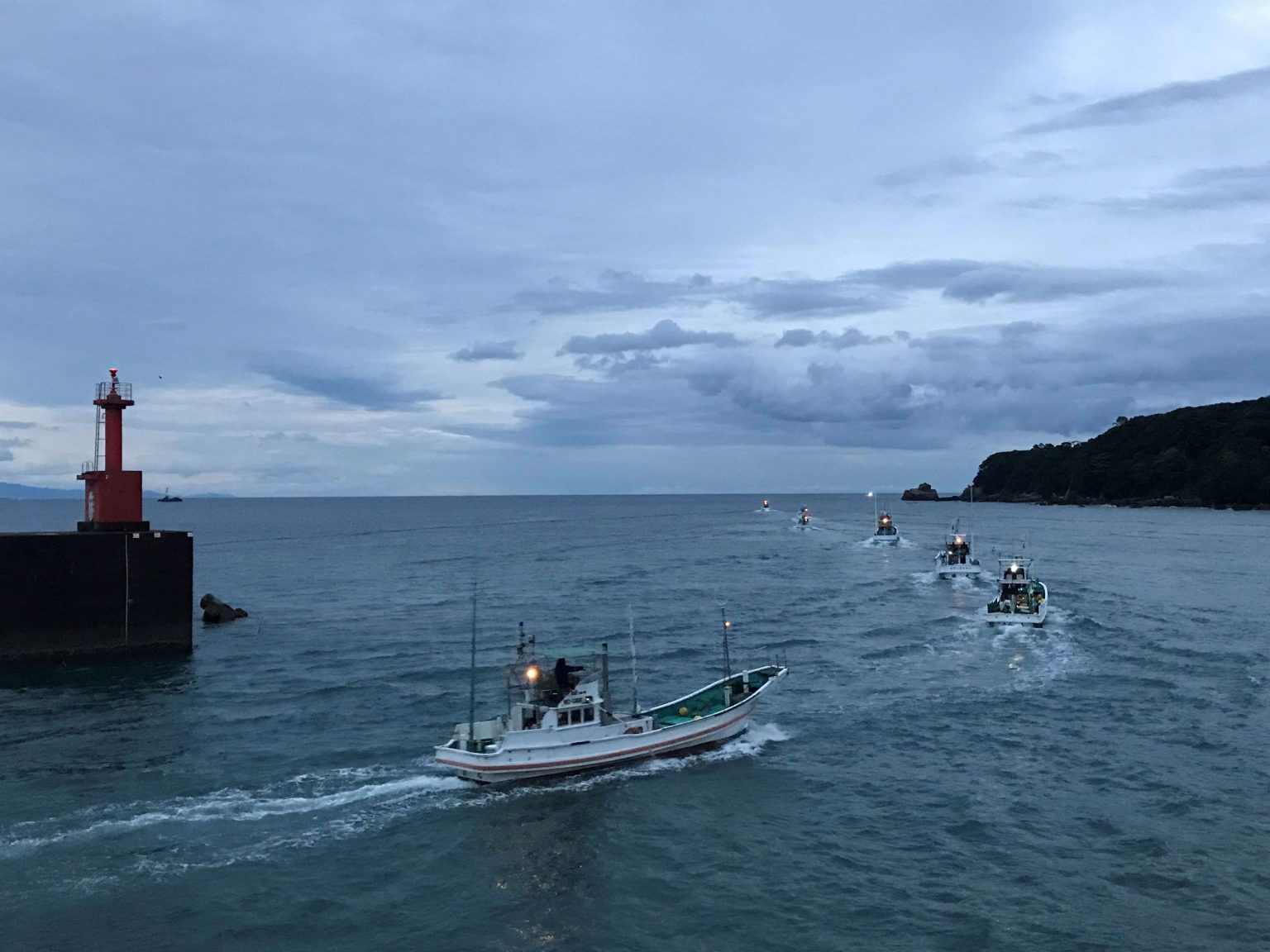Above: A modern dolphin hunt begins as ships depart from the local port.
~~
Taiji fishermen have been prowling the waters around this village for over 400 years, so you would think by now they had sampled every living thing in their stretch of ocean.
Like the dozens of other coastal communities arrayed along the southeast coast of Japan’s Honshu island, Taiji has always lived off of the whims of the sea, and especially the Kuroshio, or “Black Current.”
Named after its deep blue hue, it carries warm water up to the Japanese coast from the Philippines, a churning stream thousands of kilometers long and hundreds wide that swirls up plankton fields and carries entire ecosystems as it flows. It is a fickle provider – sea life that has appeared reliably for decades can suddenly disappear, only to come back years later, or be replaced by entirely new species.
The seasonal offerings of today – barracuda and mahi-mahi in spring, shellfish and seaweed in summer, “Ise-ebi” spiny lobsters and moray eels in the fall, and squid and blowfish in the winter – could change at any time, and the fishermen must adjust.
In Taiji, one of a handful of active whaling towns in Japan, this is also true for the small whales and dolphins that migrate with the current. The most prized of these in town is the short-finned pilot whale. One of a number of pilot whale subspecies but known locally as “the true pilot whale,” it has been a staple source of meat since antiquity, but in recent years has been in short supply.
“The migration patterns of the whales have changed. It could be because the water is slightly warmer, or because the path of the Kuroshio has changed. But the pilot whales now migrate at different times,” a dolphin hunter said.

Changed Migrations, New Species
This is a problem for the fishermen, because the hunts are tightly regulated, with strict quotas and limits to the months they can be active. The hunting season runs from September through March every year, and when whales come outside of that time frame they cannot be touched.
The men had, however, noticed a new trend during the hunting months – large pods, hundreds strong, of melon-headed whales, a species slightly smaller than pilot whales, named after their rounded domes.
“We made an official request to the government for permission to hunt the new species. After several years they decided that there were enough for sustainable hunts, and so we were given a quota,” the fisherman said. “They are actually easier to catch.”
In 2017, the Fisheries Ministry allotted two new species to the Taiji hunts, melon-headed whales and rough-toothed dolphins, which often mix their pods at sea. It was a rare case of adding to the existing quota. The ministry regulations around whales and dolphins are some of the strictest in Japan.
The new additions brought the total number of allowed species to nine, all of which are present in sufficient numbers to allow for sustainable hunts.

Pungent New Products
The remaining question was whether the meat would sell. Historical records show that short-finned pilot whales have been popular in Taiji since at least the Edo Period, hundreds of years ago. Residents favor the meat for its distinct gamey flavor and marbled texture.
Local fishmongers were unsure of the new meat at first, but were willing to try.
“Melon-headed whales have a broad diet. They eat fish, squid, anything, so the meat has a strong smell,” said a local buyer. “Other types of pilot whales eat only squid, so the meat is less pungent.”
The price was set low however, so he and a few other buyers decided to give it a try. “It is a bit difficult to process. But we prepared it dried and salted as ‘himono’ and it turned out pretty good,” he added.
Other buyers sold it raw as sashimi, including the local supermarket run by the Taiji Fishing Cooperative. Because of the dearth of pilot whales in recent years, local shoppers were also willing to try the new meat, and according to the cooperative, sales were strong.
Despite the strong smell of the meat, when served raw it turned out the meat lacked the gamey flavor of “true” pilot whales.
“It wasn’t bad. It didn’t have that strong flavor we like, but it was fine,” said a woman who runs a local inn where she often serves whale to customers. “It actually turned out that guests from outside of town enjoy it more, because it is less of an acquired taste.”
The other new species, rough-toothed dolphins, have been mainly caught live for sale to aquariums and use in Taiji’s own growing collection. The town-run Whale Museum currently has over 100 animals in tanks and sea pens.

A True Whaling Town
Taiji is one of the most active towns in Japan in hunting small whales and dolphins. The bulk of the animals are captured by the local “Isana Kumiai” union using “drive fishing,” in which pods located out at sea are driven into shore to be captured for meat or live sale to aquariums.
Unlike hunts in other regions, in which dolphins and small whales are harpooned in the open ocean, the Taiji drives are visible from the shore, and are often recorded by animal rights activists that oppose them.
Outside of a handful of countries and Native American communities, whale meat never became popular in the West, even before the whaling bans that went into effect in the 1980s. This is despite repeated efforts to popularize it as a plentiful resource when more traditional meats were in short supply. In 1918, the American Museum of Natural History held a dinner to popularize humpback whale steaks during shortages from World War I. And in the 1950s “whacon” was advertised to British housewives as a corned beef alternative during rationing in the postwar era. Neither effort took root.
In Taiji, the fishermen and residents have a recorded history of catching and consuming local whales and dolphins that dates back to at least 1606. The local food culture, however, is still evolving, as the town reacts to changes in the Kuroshio and local conditions. This season’s hunt has seen several catches of “true” pilot whales, the meat from which sold quickly, but none yet of melon-headed whales.
.
Author: Jay Alabaster

